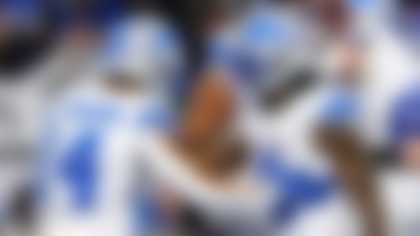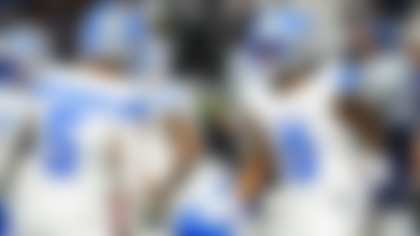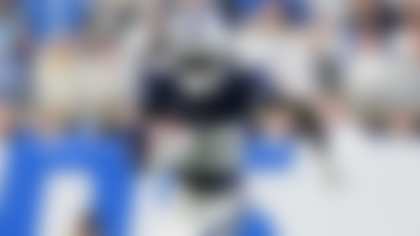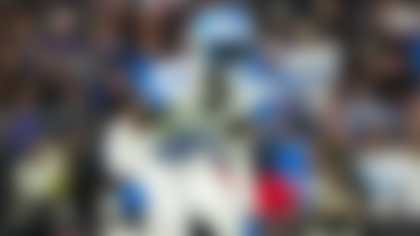COLLEGE STATION, Texas -- Last Thursday provided the sports world with another one of those uniquely this-day-and-age moments, not unlike Tebowmania or Linsanity, that seem huge as they're unfolding but have relevance that melts as quickly as an ice cube on a Texas sidewalk.
Johnny Manziel's pro day was, to be sure, one of a kind.
The helmet. The shoulder pads. The media. The music. The former president. The former first lady. Their dogs.
Add it up, and you had an event that felt more like a tool of performance art than personnel evaluation.
So ... different?
"You got that right -- right from when the whole thing started," Jacksonville Jaguars head coach Gus Bradley said. "But it was good. It was a really competitive atmosphere. They had different drills set up for him, and that showcases what Johnny is all about. You knew it was going to be spirited, you knew it was going to be competitive-type throws that he had to make. And he really did a nice job."
That much most people in the building agreed on. In a scripted workout built to make him look good, Manziel delivered.
But what, exactly, changed? That's what we'll look at here.
Start with this: There's only so much that any player can accomplish in such a setting. And what there was to accomplish, it's fair to say, Manziel pretty much did accomplish.
"I thought he did a nice job," Houston Texans general manager Rick Smith said. "Obviously, it's only a piece of the evaluation puzzle. And so, you know what kind of football player he is, you want to see the arm strength live. I've seen this guy play live multiple times. So you're just looking for him to come out, be accurate, be in control of the situation and environment, and he certainly was today."
Want to nitpick? There's room for that, too.
Controlled as it might have been, the presentation of the day actually set up Manziel for a potentially mighty big fall. Had he failed, it would've looked like a clown show. And with that in mind, several evaluators mentioned it being another example of Manziel adeptly compartmentalizing pressure and handling a big stage.
That's who Manziel was through 863 throws, 345 runs and 26 games at Texas A&M. That's who he proved to be again. And you can keep that theme going, as this workout was more confirmation than revelation, which is usually the way pro days go.
"I think if you liked Johnny before, you like him more now. And if you didn't like Johnny coming in, you still don't like him," one NFC assistant coach who was in attendance said, after a few days to digest. "Johnny's his own guy. ... But there was energy, he took command of the group, it was well planned-out, he got them out of the huddle; the shoulder pads and helmet were a nice touch. And he threw the ball well. He threw the (expletive) out of the deep ball."
On the flip side, a number of evaluators pointed out that Manziel's ball wobbled a little more than expected, and that he wasn't fantastic throwing to his left, either from the pocket or when rolling out. Others didn't deny the problems were there, but considered them more minimal.
Manziel completed 61 of his 64 passes, but in an environment like this, it's more about how the ball gets there, since there isn't coverage or a legitimate pass rush.
"He did good," said one NFC area scout who's evaluated him for two years. "He did struggle to the left, and the ball fluttered when he'd try and force it in. Also, we didn't really see him drive it downfield."
Most agreed that, overall, Manziel's arm strength is fine. The aforementioned NFC assistant coach called it better than Blake Bortles' and Teddy Bridgewater's, and a half-dozen others agreed that the former Heisman Trophy winner is somewhere between average and above average (while not outstanding) in that area.
The bigger question lingering is his ability to sit in the pocket, read a defense and throw on time, an attribute that any team will be projecting going forward.
"I'd like to see him hitting more moving targets -- the crossers, the seam throws," one AFC college scouting director said. "It's not like he was throwing full-speed seams. A lot of it was a placement thing, and that's what he does well. You didn't see the full-speed crossing routes, dig routes. Even the one dig they ran, it wasn't really fast. I'd say the one thing I'd want is more of that.
"But even if he threw that stuff and did it well, his weakness is seeing the defense and delivering the ball over the middle of the field. Even if he did it there, that shouldn't change your opinion, because there aren't 11 defenders out there."
And that leaves us with what he has left to prove.
Next up for Manziel will be a host of private workouts in Texas and visits to team facilities. He had one of the former on Friday with the Minnesota Vikings, and he will have one of the latter with the Cleveland Browns in the next few weeks.
To be sure, he'll still have to answer questions about his personal life and whether or not he's really grown up.
It's fair to wonder if money will affect his drive, though he's never been scraping for quarters and it's not like his celebrity will grow exponentially in the NFL, considering the college stardom he achieved. Most believe his love of football -- which was apparent during the pro day -- will trump the ancillary stuff.
After he answers for his off-field antics, it'll be time to put him on the chalkboard. Few question that Manziel has the mental capacity to absorb whatever's thrown at him, but taking those teachings to the field is more difficult. And what he did at A&M is much different than what he'll be asked to do within an NFL offense, which means he's a projection, from that standpoint. Evaluators who yearn to decipher how Manziel sees the field will, at least, get a better look in the meeting room than from watching him throw against air.
"If you're bringing him in, start throwing protections at him, then spend an hour or two passing him around the building to different people," the AFC college director said. "Then bring him back and see what he retains. ... You want to go over his (college) offense, too: What protection is this? What's this, what's that? Athletically, he's very good; his arm is plenty strong; accuracy is good enough. But you have to make sure he'll be able to perform and execute the offense you want him to run."
Manziel walked into the bubble in College Station last week as a different kind of prospect, and he also left as one. Most believed beforehand that, if he's going to play early, he'll need an offensive coordinator flexible and creative enough to fit a system around his skills -- and that hasn't changed, either.
So Manziel likely will be accommodated outside the NFL norm, but in those meeting rooms, whether he has the capacity to grow from there within normal pro confines becomes an operative question -- one of the few left as teams work to close his file.
"This process is exhaustive," Smith said. "And so, the more information you can obtain on a player about who he is -- not only as a football player, but as a man, so that you can project what you are adding to your organization -- the better. That's the part of the process that we're dealing with with all of these prospects."
That process is just about complete. Manziel has done nearly everything he can to this point.
And sure, he did a nice job at his pro day, thriving, again, under a searing spotlight. But chances are, within a couple months, we'll all be able to see it for the footnote it really was.
Follow Albert Breer on Twitter @AlbertBreer.



